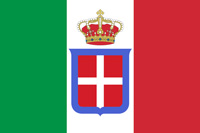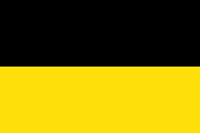World War I (1914-1918)

First Battle of the Isonzo
The First Battle of the Isonzo was fought between the Armies of Italy and Austria-Hungary on the Italian Front in World War I, between 23 June and 7 July 1915.
The aim of the Italian Army was to drive the Austrians away from its defensive positions along the Soča (Isonzo) and on the nearby mountains.
Although the Italians The Kingdom of Italy was a state that existed from 1861, when Victor Emmanuel II of Sardinia was proclaimed King of Italy, until 1946. The state resulted from a decades-long process, the Risorgimento, of consolidating the different states of the Italian Peninsula into a single state. That process was influenced by the Savoy-led Kingdom of Sardinia, which can be considered Italy's legal predecessor state. enjoyed a 2:1 numeric superiority, their offensive failed because the Italian commander, Luigi Cadorna, employed frontal assaults after impressive (but short) artillery barrages. The Austrians had the advantage of fighting from uphill positions barricaded with barbed wire which were able to easily resist the Italian assault.
The Kingdom of Italy was a state that existed from 1861, when Victor Emmanuel II of Sardinia was proclaimed King of Italy, until 1946. The state resulted from a decades-long process, the Risorgimento, of consolidating the different states of the Italian Peninsula into a single state. That process was influenced by the Savoy-led Kingdom of Sardinia, which can be considered Italy's legal predecessor state. enjoyed a 2:1 numeric superiority, their offensive failed because the Italian commander, Luigi Cadorna, employed frontal assaults after impressive (but short) artillery barrages. The Austrians had the advantage of fighting from uphill positions barricaded with barbed wire which were able to easily resist the Italian assault.
The Italians had some early successes. They partially took Monte Nero (Monte Krn), took Monte Colowrat, and captured the heights around Plezzo. However, they were unable to dislodge the Austro-Hungarian Austria-Hungary, often referred to as the Austro-Hungarian Empire, the Dual Monarchy, or Austria, was a constitutional monarchy and great power in Central Europe between 1867 and 1918. Austria-Hungary was one of the Central Powers in World War I, which began with an Austro-Hungarian war declaration on the Kingdom of Serbia on 28 July 1914. troops from the high ground between Tolmino and the Isonzo, which would later form a launching off point for the Caporetto Offensive. The heaviest fighting occurred around Gorizia. In addition to the natural defenses of the river and mountains, bastions were created at Oslavia and Podgora. The fighting at Gorizia consisted of street-by-street urban combat interspersed with artillery fire. Italian troops, such as the Italian Re and Casale Brigades, were able to advance as far as the suburbs but could get no further and were driven back. They made small footholds at Adgrado and Redipuglia on the Karst Plateau south of Gorizia but were unable to do much else.
Austria-Hungary, often referred to as the Austro-Hungarian Empire, the Dual Monarchy, or Austria, was a constitutional monarchy and great power in Central Europe between 1867 and 1918. Austria-Hungary was one of the Central Powers in World War I, which began with an Austro-Hungarian war declaration on the Kingdom of Serbia on 28 July 1914. troops from the high ground between Tolmino and the Isonzo, which would later form a launching off point for the Caporetto Offensive. The heaviest fighting occurred around Gorizia. In addition to the natural defenses of the river and mountains, bastions were created at Oslavia and Podgora. The fighting at Gorizia consisted of street-by-street urban combat interspersed with artillery fire. Italian troops, such as the Italian Re and Casale Brigades, were able to advance as far as the suburbs but could get no further and were driven back. They made small footholds at Adgrado and Redipuglia on the Karst Plateau south of Gorizia but were unable to do much else.
On the Austrian-Hungarian side two commanders distinguished themselves: Major General Géza Lukachich von Somorja, commander of the 5th Mountain Brigade, who retook Redipuglia, and Major General Novak von Arienti who retook Hill 383 with his 1st Mountain Brigade.
Early in July the commander of the Austrian Fifth Army, General Svetozar Boroević, received two reinforcement divisions, which put an end to the Italian efforts at breaking through the Austrian lines.
The final Italian gains were minimal: in the northern sector, they conquered the heights over Bovec (Mount Kanin); in the southern sector, they conquered the westernmost ridges of the Kras plateau near Fogliano Redipuglia and Monfalcone.
HISTORY

RESOURCES
This article uses material from the Wikipedia articles "World War", "World War I", and "First Battle of the Isonzo", which is released under the Creative Commons Attribution-Share-Alike License 3.0.
© Stories Preschool. All Rights Reserved.










